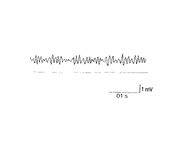Assessment |
Biopsychology |
Comparative |
Cognitive |
Developmental |
Language |
Individual differences |
Personality |
Philosophy |
Social |
Methods |
Statistics |
Clinical |
Educational |
Industrial |
Professional items |
World psychology |
Biological: Behavioural genetics · Evolutionary psychology · Neuroanatomy · Neurochemistry · Neuroendocrinology · Neuroscience · Psychoneuroimmunology · Physiological Psychology · Psychopharmacology (Index, Outline)
Ocular microtremor (OMT) is a constant, physiological, high frequency (peak 80Hz), low amplitude (estimated circa 150-2500nm (1)) eye tremor.

Ocular microtremor tracing with burst sections underlined
It occurs in all normal people even when the eye is apparently still and is due to the constant activity of brainstem oculomotor units. In coma there is a loss of high frequency components of tremor and the extent of this reduction is related to the patient's prognosis (2). Ocular microtremor can help in the difficult diagnosis of brainstem death, as well as monitoring patients while under anaesthesia (3). Abnormal OMT records are seen in neurological conditions such as parkinson's disease and multiple sclerosis(4). The frequency spectrum also changes with age.
The first description of what is now known as ocular microtremor was made in 1934 (5). It is contentious whether ocular microtremor assists vision. "Visual processes deteriorate rapidly in the absence of retinal image motion." Journal of Vision
References[]
1. Sheahan, N. F., D. Coakley, et al. (1993). "Ocular microtremor measurement system: design and performance." Med Biol Eng Comput 31(3): 205-12.
2. Coakley, D. and J. G. Thomas (1977). "The ocular microtremor record and the prognosis of the unconscious patient." Lancet 1(8010): 512-5.
3. Bojanic, S., T. Simpson, et al. (2001). "Ocular microtremor: a tool for measuring depth of anaesthesia?" Br J Anaesth 86(4): 519-22.
4. Bolger, C., S. Bojanic, et al. (2000). "Ocular microtremor (OMT): a new neurophysiological approach to multiple sclerosis." J Neurol Neurosurg Psychiatry 68(5): 639-42.
5. Adler, F. H. M., Fliegelman, Maurice (AB) (1934). "Influence of Fixation on the Visual Acuity." Archives of Ophthalmology 12: 475-483.
See also[]
| This page uses Creative Commons Licensed content from Wikipedia (view authors). |